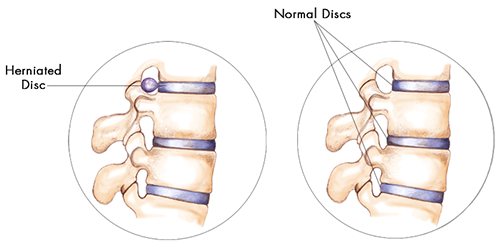Herniated Disc Symptoms
A herniated disc is a fairly common condition. As discs degenerate, the inner material in the disc can leak into the spinal canal. This is a condition known as a herniated disc or disc herniation. When the inner material of the herniated disc reaches the spinal canal, the material puts additional pressure on the nerve, resulting in pain.
What Is a Herniated Disc?
A herniated disc is a degenerated spinal disc that has become worn down due to age or injury. When the outer layer (annulus fibrosus) begins to weaken, the inner gel-like material (nucleus pulposus) can rupture through the outer wall. This rupture of the inner portion of the disc is what is referred to as disc herniation or herniated disc.
Herniated Disc Locations
As with many spine conditions, a herniated disc can occur along the spine. However, the most common location is the lumbar region or lower back. This is due to the constant impact this area bears, especially when standing or sitting.
A herniated disc can occur in the:
- Cervical spine (neck) – C1 through C7 vertebrae
- Thoracic spine (upper back) – T1 through T12 vertebrae
- Lumbar spine (lower back) – L1 through L5 vertebrae
The location of the herniated disc will determine the symptoms someone will experience. Most symptoms include pain, weakness, and numbness. In some extreme cases, a restricted range of motion can also be experienced. However, these symptoms will vary according to the location.
Lumbar Herniated Disc Symptoms
The lower back is the most common location for herniated discs. Because the lower back serves as a primary shock absorber and supports the upper body, spinal discs in this area tend to wear down faster. Some of the common symptoms associated with lumbar herniated discs include:
- Leg pain that radiates along sciatica.
- Sharp, radiating, electric, and piercing pain spasms in the legs.
- Pain that radiates to the buttocks, thigh, calf, or foot.
- Difficulty lifting the foot when standing or walking.
- Lower back pain that is described as throbbing or dull, with stiffness.
- Pain that worsens with movement or hunching forward.
Thoracic Herniated Disc Symptoms
Although thoracic herniated discs are less common, it often occurs at the mid back. Most thoracic spine conditions are asymptomatic, which is why most people live with a herniated disc in this area without notice. Herniated disc in the thoracic spine can occur in central, lateral, or centre-lateral directions. These are the most common symptoms:
- Upper back pain.
- Pain that radiates to the chest wall or abdomen.
- Radiating pain that reaches the upper back.
- Myelopathy or spinal cord dysfunction.
Cervical Herniated Disc Symptoms
Because the space in the cervical spine is limited, even the smallest herniation can impinge on adjacent nerves causing significant pain. Symptoms from a cervical herniated disc are often experienced in the arms, neck, hands, and fingers, as well as sections of the shoulders. Symptoms will also vary according to the nearby vertebrae affected. The most common symptoms include:
- Shoulder pain and weakness in the upper arm.
- Weakness in the biceps and numbness or tingling that can radiate to the thumb side of the hand.
- Numbness, weakness, and tingling along the triceps into the middle finger.
- Difficulty or weakness with handgrip and pain that radiates to the little finger side of the hand.
Herniated disc symptoms are often confused with other conditions such as pinched nerves, sciatica, or frequent neck pain. This is why discussing all symptoms with a physician can help those experiencing similar symptoms pin point their condition and discuss possible treatment options.

